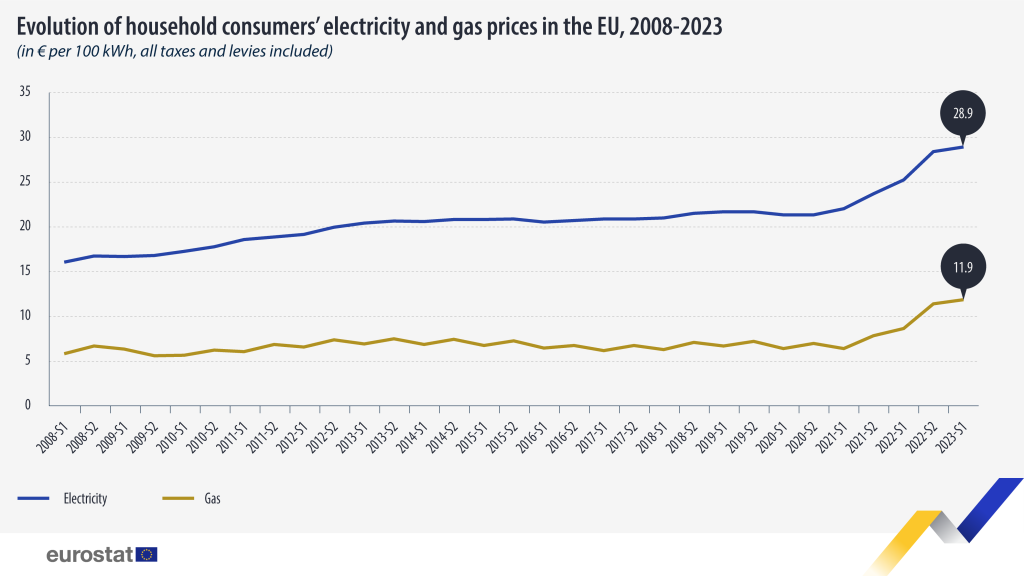“I tapped it again the next morning, and it went up still higher, and the rain came down faster than ever. On Wednesday I went and hit it again, and the pointer went round towards “set fair,” “very dry,” and “much heat,” until it was stopped by the peg, and couldn’t go any further. It tried its best, but the instrument was built so that it couldn’t prophesy fine weather any harder than it did without breaking itself. It evidently wanted to go on, and prognosticate drought, and water famine, and sunstroke, and simooms, and such things, but the peg prevented it, and it had to be content with pointing to the mere commonplace “very dry.”
Meanwhile, the rain came down in a steady torrent, and the lower part of the town was under water, owing to the river having overflowed.[1]“.
I don’t know why I remember this episode from Jerome K. Jerome’s classic novel when I read a relatively dry (ah dry, maybe that’s why) announcement about energy costs for residential space heating that the Energy Agency of the Republic of Serbia issues every year in October.
In that announcement, the Agency, based on some assumptions about consumption, efficiency and on the basis of energy prices (or also assumptions?), compares the costs of different variants of heating a residential space of 60 square meters. The agency does not compare all variants because we cannot find out anything about the costs of district heating, nor about the costs of heating with heat pumps or air conditioning.
The announcement is, as it should be, terse and mostly exact, only here and there does emotion break through and some adverbs (only) or descriptions of benefits (but which is comfortable…) appear.
This barometer 2020 in October informs the citizens of Serbia of good gas weather, so it consoles them that even though this heating is not the cheapest, it has an additional advantage in terms of the comfort it provides[2]. Meanwhile, the International Energy Agency complains that prices in the markets are at historically low levels due to the pandemic[3].
In 2023, the pointer moves forward and informs citizens in October that households that heat using natural gas will have the lowest costs[4]. The barometer of the International Energy Agency, in the same month of the same year, finds that the 2021/2022 gas year begins with record high prices on the markets in Europe and Asia and lower levels of stocks in warehouses, and the barometers of respected American media say that they hope that stratospheric gas prices in Europe caused by the global energy meltdown will not affect prices in the US to the same extent[5].
Our well-intentioned barometer continues to show “households heating with natural gas have the lowest costs” time and time again in October 2022[6]. The ominous birds from the International Energy Agency are crying in the same month that the winter season opens with record high prices and price volatility caused by some problems related to Russian gas deliveries[7].
In October 2023, we are witnessing somewhat worse weather, so the barometer says “Heating using natural gas will also be favorable this heating season in relation to other types of heating because it will amount to 59.5 thousand dinars, which is only 3.5 thousand dinars more expensive than the most favorable heating using wood”[8]. Those boring people looked at their barometer and noticed that market tensions in the first three quarters of 2023 have decreased, but that supply is limited and prices are extremely unstable[9]. Meanwhile, the barometers in Europe are drawing nonsense.

In 2024, we continue to witness “just a bit more expensive than the best” time[11]. You already know without me telling you: the International Energy Agency complains about the weak outlook, sensitivity and geopolitical tensions that affect the unpredictability of prices, and it also complains about the rise in gas prices on all markets in the second quarter of 2024.
After all, their international time is their problem. Our public policies have brought us good gas weather, and cheap gas heating for users who burn their own wood. We assume that there is no reason why it should not be cheap for the users of district heating, for whom the same gas is burned by other people, so the heated water is pumped and pushed through thousands of kilometers of pipes to their radiators. We do not know exactly, because the Agency does not show their costs in a comparative analysis.
We also love good weather and look forward to our fellow citizens heating themselves cheaply!
Sometimes we wonder why do we prepare them using taxpayers’ money to pay those cheap bills themselves and why do we give them money they are happy to use[12] (we will write about this soon) to buy new boilers. Are you wondering too?
Nevertheless: be the Republic of Serbia, don’t be the International Energy Agency. Nor Eurostat.
They are being far too negative.
[1] Jerome K. Jerome, Three Men in a Boat (To Say Nothing of the Dog), Chapter V, Penguin Books, 1994.
[2] http://aers.rs/Index.asp?l=1&a=541&id=262&tvid=1
[3] https://www.iea.org/reports/gas-2020
[4] http://aers.rs/Index.asp?l=1&a=541&id=285&tvid=1
[5] https://www.iea.org/reports/gas-market-report-q4-2021/main-findings
[6] http://aers.rs/Index.asp?l=1&a=541&id=317&tvid=1
[7] https://iea.blob.core.windows.net/assets/5c108dc3-f19f-46c7-a157-f46f4172b75e/GasMarketReportQ42022.pdf
[8] http://aers.rs/Index.asp?l=1&a=541&id=340&tvid=1
[9] https://www.iea.org/reports/medium-term-gas-report-2023
[10] https://ec.europa.eu/eurostat/documents/4187653/16179947/vis1-Electricity-and-gas-261023.png/722092b0-9465-b280-47cf-85307ae86c3a?t=1698302182681
[11] https://www.aers.rs/Index.asp?l=1&a=541&id=360&tvid=1
[12] See Measure 4 users here (and many other places) https://www.kovin.rs/wp-content/uploads/Odluka-o-utvrdjivanju-ispunjenosti-uslova-i-utvrdjivanju-liste-krajnjih-korisnika.pdf
